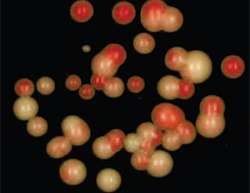How genes are permanently silenced by small RNAs

Marc Bühler and his team at the Friedrich Miescher Institute for Biomedical Research (FMI) have elucidated the mechanism underlying small RNA-mediated gene silencing, thus solving a mystery which has been puzzling the research community for over a decade. Their findings, published today in Nature, have great potential for applications in various fields.
Back in 2002, the discovery by several research groups that small RNA molecules can shut down clearly defined genome regions was hailed by Science as the Breakthrough of the Year. There was great excitement, as scientists now appeared to have a tool that would allow them to influence the genome without directly modifying the DNA. However, as the years went by and efforts to explain the mechanism in detail proved difficult, the initial excitement gave way to frustration. FMI Group leader Marc Bühler recalls: "Contradictory data, papers withdrawn – we were making little progress. For a while, I'd also given up hope that we'd ever get to the bottom of this." But they succeeded.
As the scientists report in Nature today, a group of proteins known as the Paf1 complex (Paf1C) – itself part of the RNA polymerase complex – prevents small RNA molecules from silencing sections of the genome. When Paf1C was mutated in yeast, RNA fragments could be used to shut down targeted genome regions. This effect is robust and long-lasting. Bühler says: "In our experiments, we showed that gene silencing is also maintained in the next generation, even when the original RNA molecule is no longer present. So what we've discovered is a wholly epigenetic mechanism: we can alter gene expression across generations – and thus influence cell development – without directly changing the DNA sequence."
To obtain these results, the joint first authors of the publication, Katarzyna Kowalik and Yukiko Shimada (both members of Bühler's group), used an elaborate yeast genetic screen which had fallen out of fashion among the research community in recent years. Bühler explains: "After the setbacks of the past few years, we went back to this 'old' method and combined it with whole-genome next-generation sequencing techniques. That was the recipe for success."
Paf1C is a protein which also occurs in higher organisms, in a form scarcely differing from that in yeast. Bühler comments: "It's intriguing that we can now use RNA molecules to induce epigenetic gene silencing in a sequence-specific manner, and that the same protein also occurs in mammalian cells; this may open up new avenues for RNA-based therapeutics. At the same time, a number of well-known obstacles remain to be overcome."
Accordingly, Bühler believes the discovery is currently of particular interest in a non-medical field: "These RNA mechanisms have long been researched in plant biotechnology, where epigenetic control over gene expression could obviate the need to generate genetically modified organisms."
More information: "Molecular biology: RNA interference hangs by a thread." DOI: 10.1038/nature14376

















